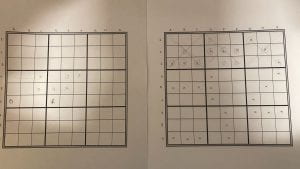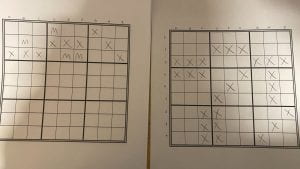The link of the intial game lies here: https://docs.google.com/document/d/1Yp_ar11r5YD4KgCzbWW-UJo9-Me2pTxPWS2h1F9NL3A/edit
I tried my best to ritualize the procedure of the game in an Onoesque way that simplifies everything to the extent that the game is almost unbearably simple, and provided very straightforward and malleable insturctions for each and every step, as an Ono piece would radiate that sort of energy.
The procedure of playing this game extended into crazy and unrestricted interpersonal gameplay, which was my designated plan. That sort of freedom of interpretation took away some constraints of a traditional TRPG and made a fun experience that is easily understood and replayed. I did hope that the extensive usage of the d6 would also bolster that accessibilty and create a party game that would help people enjoy instead of feel constraint in almost any sense. I tried and the rhytm of the game was highly malleable, which also resonates with how simplicity was the central theme of Ono’s works.
Despite liking the sense of this artwork, I find that I would need to be better with people to have the best fun in this game.

Projects
A Drumming Party Game!
Originally, I wanted to appropriate the movie Blue Giant which came out recently, its about teenagers who want to play jazz and one wants to become the best jazz musician in the world. This movie has an incredible soundtrack and I wanted to appropriate it for this project so that people could feel that excitement of playing together as the teenagers did in the movie and the same way I have in previous bands. I started out with a concept about jazz music where each player would be playing a different instrument and after learning the play their instruments in the gamified way, they would be able to play together. Upon presenting this idea to my class, the lack of enthusiasm made it clear to me that my idea for the mechanics was uninteresting and the concept too confusing so, I scrapped it and started over. At its core, I wanted people to enjoy making music together when I remembered that during a vacation I went on, the staff of where we were staying, gathered us for a drum circle night of playing and dancing and I remember, despite never having played with these people, you could still have fun however in a much more casual way than jazz typically is. So, for my in class playtest, I brought in a multiplayer rhythm game where players learn to play quarter, eighth, and sixteenth beats. Once learning all these types of rhythms, they had an opportunity to play together. It was during this playtest that I realized, many people who have never experienced reading rhythm notation may struggle with this game so I simplified it for the final version.
In the final version, after each time they learned a new “skill” ie. a quarter beat, eighth, silent or free square, players each got a part and had an opportunity to play together! This minimized the pain of learning each new type of rhythm because players had more opportunity to play together than the previous iteration which kept players more engaged.
I think if I were to continue working on this game, I would add in the sixteenth beats next for players that want a challenge and also allow each player to pick different difficulties so more complex rhythms can be created for those with more experience, and simpler rhythms for players that are new to drumming so they are not overwhelmed.
While I don’t think that my appropriation of drumming circles here quite parallels the readings about artists during the dada era, I think in the general concept of artists stealing parts from things that inspire them and want to use those things to create some emotion in their audience or share their perspective, we are similar.
View the final project here! –>https://docs.google.com/presentation/d/1LicYVpAYDTwsX63m1Ydw8YuLkEHwAmsqyqm5RDUIaz0/edit?usp=sharing
First draft of project party game–> https://docs.google.com/presentation/d/1EhXa9rFqUOjQU7nrzzBMya-cqFzBVC-i0yMby5fO33A/edit?usp=sharing
playtest notes–> https://docs.google.com/document/d/1AVBal4TWfIEXbFqE30LrdEDK59G3CI8ElFbTVnnq1RY/edit?usp=sharing
Tic-Tac-Toe Where?
Game Rules:
Preparations
- 4 sudoku tables labeled A – I horizontally, 1 – 9 vertical
- Each player marks 3-in-a-row on each 3-by-3 grid on the board as a means of winning, Make sure your opponent cannot view your board.
Playing
- On each turn, players would “attack” the board to see where the enemy has placed their markers on the blank board. When attacking, announce to your opponent the grid you are attacking.
- The opponent must tell whether the attack hit or missed. If the attack missed, the player that attack may go again.
Goal
First to find 3-in-a-row of the 3 x 3 square of the opponent will win.
Artist Statement
Initially, I started with a Yoko Ono inspired work where the tic tac toe game would create an infinite game of tic-tac-toe. I wanted to create a distinctive art piece through a game with the only added rule being “add a line anywhere on the page after you play your move in tic-tac-toe”. The games became messy and interesting as people were forced to think outside of the box about their next move until realizing that they would never win. The best part was seeing people coming to this realization and seeing the way that their strategic play-style from before changed into pure chaos. It was a creative spin to the game however, it wasn’t as climatic as I expected it to be. (Playtest result see below)
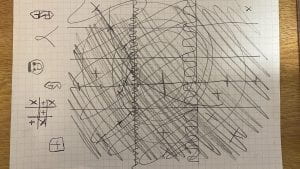
As a result, I decided to do a mashup of different games together to create a intensive game of tic-tac-toe using a sudoku board and the gameplay of battleship to create a fun and different spin to the game. Initially with this iteration, I started with a basic tic-tac-toe board, but I feel like the game would be too brief for players to feel the fun before it is over. Thus, I adopted the idea of using the sudoku board as it is comprised of 9 tic-tac-toe boards together while also creating a larger 3 x 3 board.
Overall, I felt that artists during the DADA movement were having fun with their work while trying to iterate on previously-created works of art. Iterating on my own idea reminded me a lot of Marcel Duchamp as he has appropriated his own works so many times. In a way, iterating and improving upon an idea could be appropriation as I had changed the ideas and made it into my own. Like artists during the DADA movement, I had fun trying to think of various ways to iterate and add more to a simple game of tic-tac-toe that I’ve known all my life.
Headbandz Appropriation
In a world of conflict, the Dada movement developed as a daring response to the war, embracing the bizarre and senseless. The chaos of World War I provided fertile ground for the Dadaists’ revolutionary spirit, as they used art to transcend reality’s darkness into a realm of absurdity, satire, and amusement. Using inspiration from this, I appropriated the board game “Headbandz” to craft an experience that serves as a playful counterpoint to the somber undertones of the Dada movement, infusing it with a sense of light-heartedness and pure enjoyment.
My journey began with a desire to harness the Dadaist spirit of rebellion and absurdity, transforming “Headbandz” from a game centered around objects into an ensemble of diverse video and board/card games. Rather than appropriating the tension of war, I aimed to infuse a sense of lightheartedness and fun into the experience. Through the reinterpretation of cards, I have provided a platform for players to escape the weight of reality and immerse themselves in a world that they are familiar with, by reminiscing about some of the most popular games in recent times.
The game works similarly to how “Headbandz” originally works, but instead of guessing random objects players are guessing popular games within recent times. Since this is a games course, I thought appropriating the “Headbandz” game to be about video/board/card games would be fun. Since I wanted the game to fit the lighthearted feel, I tried to think of popular games that everyone would know so players could reminisce once they figured out what their game was. I play-tested it in class as well as in the final iteration and everyone seemed to enjoy guessing and talking about popular games that they played growing up. I got some suggestions about making it a bit faster since it took a decent amount of time to play so I decided to have two game modes, one for a quicker game and one for a longer version. The quicker one would be timed and each player would have 30 seconds to ask as many yes or no questions about their game to try and figure it out. Once the 30 seconds was up, it would move to the next person and repeat the process until someone guessed their game correctly. For the longer version, there would be no timer involved and each player would ask a yes or no question about their game. If the answer to their question was a yes then they would keep asking questions until the answer was no and then it would be the next person’s turn. This process would repeat until everyone guessed their game correctly.
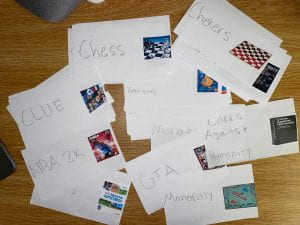
Texas Holdem -but with action card!
To play the game, first, you need to know about a regular Texas holdem. Texas Hold’em’s a card game with four times to bet. Everybody gets two cards, and there are five more cards on the table. You can choose to drop out, match the bet, or raise during the betting times. The point is to make the best hand you can with your cards and the ones on the table. The person with the best hand wins. The dealer button moves around the table, and your goal is to win chips from the others.
But in this version:
Alongside the regular number cards, there are also “action cards” mixed into the deck, in order to add a twist to the gameplay.
Players have the freedom and are encouraged to use these action cards at any point during the game. when a player decides to play an action card, they must draw another card from the deck, to keep the same number of cards in their hand.
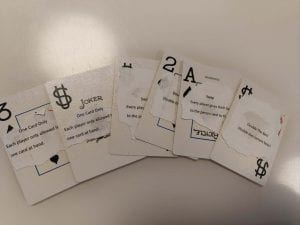
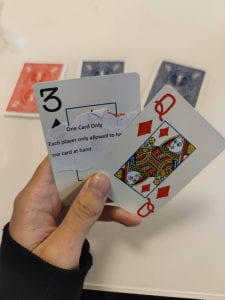
Betting:
Also, in this version, you are not betting with chips. Instead, you are betting with the parts of your body. For example, If I have a good hand, I may raise the bets to 1 eye. At the end of the round, the one with the strongest hands can keep his/her bets, while the other players can’t use one of his eyes for the rest of the game. The player loses the game when the player is unable to continue playing with no eyes or no fingers.

Artist statement:
This project is inspired by the appropriations in the Dada movement. This project reflects the Dadaist approach of taking existing objects and recontextualizing them to create unexpected art. There were lots of appropriations about chess during the movement, for example, Yoko Ono’s Play It by Trust, Takako Saito’s Sound Chess, and Spice Chess. My initial idea was to combine poker with UNO, so the cards dealt were UNO instead. But when I searched “Poker * UNO” on Google, I found someone in this class had a similar idea and already posted it in 2016. Therefore instead of UNO, I combined it with action cards. Those action cards brought more randomness and strategies to poker. Players in this game can also use action cards at any time, altering the gameplay in unexpected ways. This is also a kind of appropriation as Dada art often featured unexpected and irrational elements.
Unfair Monopoly
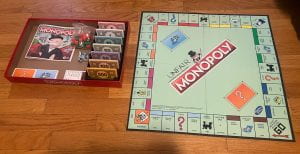
^ The initial setup of the game
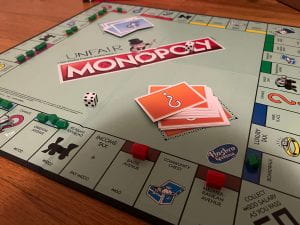
^ The board after a short and quick playthrough
Unfair Monopoly is a version of Monopoly with modified rules:
- The player order is decided by a dice roll. (Highest roll = Player 1)
- Player 1 starts with $5000, Player 2 and 3 start with $500, and Player 4 starts with $2.
- Player 1 starts off owning every property on 2 sides of the board (of their choice).
- Players 2 and 3 start off owning 1 property of their choice.
- Player 1 starts off with 20 houses of their choice (5 houses can become a hotel).
- Players 2 and 3 start off with 1 house of their choice.
- Player 1 “has connections” and so can get a new property for free every turn.
I’ve always thought it was interesting how much some people hate Monopoly. I’ve always enjoyed it, but it feels like you can’t bring it up without getting some groans. I think that’s for a few reasons (its length, the jail system, the fact it keeps on going after the winner is almost guaranteed…), but ultimately, all these issues–to some extent–derive from the fact that losing at this game is painful. It’s awful to have almost no spaces, and almost no money, and just sit by as you spiral into bankruptcy. The thing is, this is–in a way–the most “realistic” aspect of the game. When you’re subject to the will of much richer, more powerful players, there are few tools at your disposal to recover from that. The fact that the original version of Monopoly was created as a statement (rather than being a game for the sake of a game) says it all.
Because of that, I figured it’d be fun to ramp up the most frustrating–and most realistic–aspects of the game. What if, instead of starting off on equal footing, the characters were split into classes (Player 1 being upper-class, Players 2 and 3 being the middle class, and Player 4 being poor)? Additionally, what if Player 1–on top of having far more property and money than anyone else–also had “connections” which let them gain properties without doing any work or spending any money? That’s realistic, too. Ultimately, these changes make the game nearly unplayable, especially for Player 4, but really for anyone who isn’t Player 1.
Making this game was a weirdly cathartic experience, despite how frustrating and hopeless it’s built to be. I think that’s because I’ve always been annoyed in particular by the concept of “connections” in getting people up corporate ladders, whether or not they have the skill/ability to warrant reaching the top. Because of that, it was satisfying to “vent” about it through this game.
In a way, this game’s style of appropriation derives from the way Dada artists took pictures and corrupted/distorted them to convey the violence of World War I and the shifting of culture in the early 1900s. In the same way their collages would cut up and combine their original photos in uncanny ways, this game takes Monopoly and distorts it into something unpleasant but realistic, while being fascinating in its own way.
The core of this game has generally stayed the same throughout development, but a couple things have changed. First, Player 1 used to select 20 separate properties at the start, but that dragged on for a while during the first playtest, so now they simply select 2 full sides of the board to own. Additionally, the game now uses a proper Monopoly board (with slight visual modifications) instead of a printed piece of paper, which was originally used for proving the concept.
Ultimately, I hope this game can serve as a quirky conversation starter for people who love, or hate, the Monopoly game we’re all familiar with.
Universal Chess
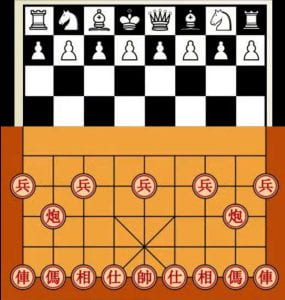
Rules:
- The rules in each half follow the respective chess rules.
- Western Chess Rules: https://en.wikipedia.org/wiki/Rules_of_chess
- Eastern Chess Rules: https://en.wikipedia.org/wiki/Xiangqi
- Since the two chess sets use different mapspace, thus when crossing the border, players can decide which near line/grid they want to enter.
- Rooks, Queen, Chariots, Canons, and Bishops will need to take a turn to pass the midline, while knights and horses don’t.
- Western pawn can be promoted into any eastern chess piece besides the general when it reaches the end, and eastern soldiers can be promoted into any western chess piece besides the king when it reaches the end.
- King can no longer cross the middle line
This appropriation is inspired initially from Duchamps and his chess art pieces. The concept of this appropriation is to demonstrate aesthetic and cultural differences between western chess and eastern chess where both of them were adapted from the same origin. The game deliberately let the chess pieces follow the moving rule of the respective board space they are in because there is an old saying in both western and eastern cultures called “When in Rome, do as the Romans do” (or ru xiang sui su in Chinese). Both of them mean when visiting a foreign land, follow the customs of those who live in it. Also, taking an extra step to cross the middle causes it to be very difficult to move one’s piece to the other side because it will be relatively easy for the opponent to defend, which somehow demonstrates that it is very difficult for a culture to enter another.
Gameplay wise, since these two chess sets have different pieces and different amounts of pieces, this game will be an asymmetrical PvP game. In respective of game balancing, for the western sides, it has 3 less special pieces (pieces besides pawns), but it has the queen which is the most powerful piece amongst all. Moreover, bishops & knights are similar but stronger than elephants & horses where knights will not be blocked by other pieces like horses do, and bishops can move in any amount in a diagonal but elephants can only move 2 grids in diagonal. For eastern sides, it has half of the amount of soldiers compared with western pawns, but they are a bit more powerful because they can capture forward or horizontal when they cross the middle where pawns can only capture in diagonal. Eastern chess has advisors and canons but advisors can only move in the 9 grids surrounding the general which has no use in offending, and canons are not as powerful as the queen. In short, western chess has less special pieces but they are more powerful and it has more pawns, whereas eastern chess has more special pieces but less powerful, and less pawns(soldiers) but a bit more powerful. Therefore, the gameplay is somehow balanced.
During the playtesting, I found that the game is relatively stagnant since it is difficult to cross the middle line, so I want to give more power to certain pieces to make the gameplay more engaging and offensive. The knights and horses are a good choice because they will not be overpowered like rooks or chariots if they can cross the middle line without taking an extra turn. Also, kings can no longer cross the middle line just to remain symmetric with the eastern general.
Disclaimer: There are no political implications in any form, anyhow, anywhere in this game.
Playtestings
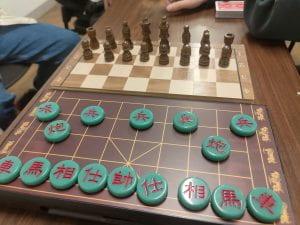
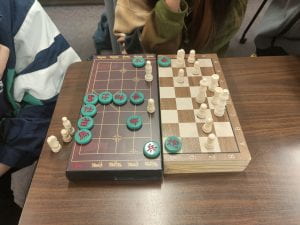
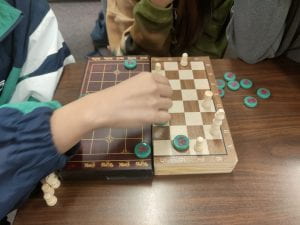
Other Variation (Speed Chess + Extend the board by 4 rows, the middle line now is between 2-3 on the western board)
Trickster Tycoons
For my appropriation project, I was inspired by Town of Salem’s Jester Role; for those of you that haven’t played Town of Salem before, the Jester’s goal is to trick the town into voting to hang them. Jester is the only role in the game that actually wants to be hanged, and this counter-intuitive gameplay is a fun and interesting challenge. That got me thinking; would it be possible to implement a similar mechanic into other games? And so, I came up with this ruleset:
- Choose a game to play. This game must be a multiplayer game for three or more players, where players are not eliminated as the game goes on, players directly compete with each other and/or have some way to affect each other’s performance in the game, and at the end of the game, players must be ranked based on their performance. For my playtest, I chose Mario Party.
- Either create your own cards, or use traditional playing cards. There must be one card for each player, and one must be very notably different from the others (such as a Joker). Shuffle the cards, and give one to each player. The player that receives the unique card is playing for last place. Everybody holds on to these cards, and nobody is allowed to show each other their cards until the end of the game.
- If the player playing for last is in last place at the end of the game, they steal victory from first place. If they come in first place, then second place wins instead.
When playing under these rules, any multiplayer party game can in theory be turned into a social deduction game, which is a dynamic that I personally think is incredibly interesting. Now, every misplay builds suspicion; when someone makes a non-ideal play, it sets off red flags in everyone else’s mind. And once players are sure they know who’s playing for last, it could turn the entire game on its head.
Sadly, my playtest was not able to capture the full potential of this premise; due to scheduling constraints, I was unable to assemble a group that was entirely familiar with the game we were playing. Dros and Kate were playing for the first time, and so were unable to more accurately choose the level they were playing at. It became way too easy for them to dismiss any suspicion I attempted to throw at them as pure incompetence. Furthermore, I feel like this could have played out better over a longer game, with more opportunities to lose Stars, give them to other players in Duels, lose coins to the slot machine, and wait for better Star Prices. Although the playtest was not a complete success, I would still argue that the potential is there; it simply needs a second opportunity to find it.
Rock Paper Scissors and Array the trains
What you need: at least 2 players, a deck of poker or more.
Inspirations: The basic rule of RPS and Chinese card game
Rules:
Two or more players, holding evenly divided cards, keep their hands face down and take turns playing cards in clockwise or counterclockwise order, with each player playing only the top card of his or her hand.
Each player may only play the top card of his or her hand. The cards are stacked up in the order in which they are played, as long as the numbers on the face of the cards are visible.
The player who finds that he or she has played any card with the same number as any of the cards stacked up on top of it will win all the cards starting with the one with the same number as the card he or she played up to the middle of his or her own hand, and then place the winning card at the bottom of the pile in his or her own hand, and that player then proceeds to take a card from the top of the pile and play the card.
The game continues until one player has won all the cards in the other player’s hand, and the game ends with the player with all the cards in their hand winning.
Rock, Paper, Scissor
- After a player place a card have numbers that matches the number of the card on table, another player can challenge him by RPS, if he lost he has to take back the card and place it under his own deck
- before placing the card, one player can can challenge another player first using RPS, if he/she wins, the player will not be able to be challenge by another player at his turn.)
Example:
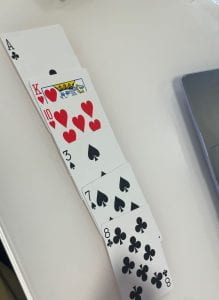 ,if the next player place a card that is either A,K,10,3,7,8- He can take all the cards in between the 2 matched cards.
,if the next player place a card that is either A,K,10,3,7,8- He can take all the cards in between the 2 matched cards.
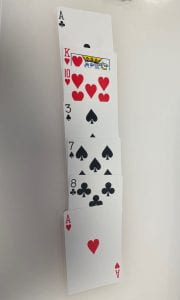 Forexample, this player draws the Ace card from his deck, he wins all the cards between the 2 Aces.
Forexample, this player draws the Ace card from his deck, he wins all the cards between the 2 Aces.
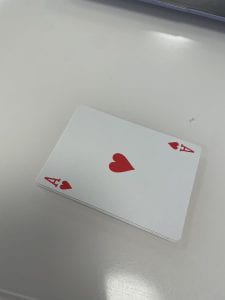 These cards will needs to be shuffled and put it under the winner’s deck
These cards will needs to be shuffled and put it under the winner’s deck
playtest:
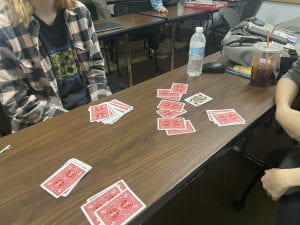

The play test went very well, my game is easy to understand and play.
Artist Statement:
Artistic appropriation is the use of pre-existing objects or images with little or no transformation of them. Appropriation holds an important place in art history. Appropriation, similar to readymade object art, is “an artistic strategy of intentionally borrowing, copying, and altering pre-existing images, objects, and ideas.” Appropriation has also been defined as “the appropriation of a physical object or even an existing artwork into a work of art.”
In my appropriation project, I draw inspiration from the avant-garde movement “DADAism.”” DADAism” emerged in the turbulent early 20th century as a reaction to a chaotic and dystopian world.DADAism’s disregard for traditional norms and challenge to conventional art styles resonates deeply with my creative process. That is, to break some kind of rule or focus on destroying integrity. The notion of “appropriation” is also integrated into the structure of the game. Just as DADA artists often repurpose readymade objects and appropriate cultural symbols, the game itself appropriates and combines the rules of two classic games and works well to produce new game mechanics. Artists such as George Grosz and John Heartfield’s art is extremely caustic and cynical. But while my game also inspired chaos with players fighting each other. However, the game doesn’t deliberately try to provoke players, and players can choose not to disrupt others’ card winning actions. The game’s “rock, paper, scissors” challenges are a subversion of traditional aesthetics, much as DADA artists attempt to subvert social and artistic conventions. Here, players utilize a “game within a game” to achieve control, causing the player who could have won the card to take the risk of winning nothing. Just as DADA artists achieve control over artistic narratives through absurdity and deconstruction.
AI Generated Telephone Game
Overview
This game tackles the topic of appropriation by combing a medium that cannot exist without appropriation – AI generated images – and appropriating the rules of pictionary and the rules of drawing telephone games such as Gartic Phone. In this game however, the creation of pictures are completely left up to the AI with the players only writing the prompts and guesses.
Rules and Gameplay
- The game can theoretically be played by any number of players, but at least 4 players recommended. Additionally 1 person is needed to be the game master.
- The game takes place in a chatroom or a Discord server, and the game master is in charge of managing the players’ prompts and images, as well as stringing the final results together.
- At the start of the game, each player writes down a phrase of no less than 5 words, and send it to the game master.
- The game master then sends each phrase to the next player, and each player enter the exact phrases into an AI image generator (craiyon is used for playtesting). Each player chooses an generated image and send them back to the game master. The players must not alter the images in any way, and it does not matter if the generated image does not resemble the input prompt.
- The game master then sends the images to the next player, and each player describe the content of the image as reasonably detailed as possible (they are also allowed to twist and remix their own interpretation of the image if they wish).
- The players sends their new descriptions back to the game master, who pass them to the next player.
- After at least as many rounds as the amount of players have taken place (the game can go on for longer if there are few players or if the players wish to), the game master presents the result of the telephone game.
Artist’s Statement
When I think about the word “appropriation”, my mind immediately jumps to the current hot and controversial topic of AI image generators and how all of them are based on the countless amount of harvested data from across the internet to generate new images based on these data. As a hobby digital artist, I definitely agree with the many ethical problems raised with generative AI, especially in how their data are overwhelmingly gathered and used without the original artists’ or photographers’ consent. However, I also think that there is one area that AI is almost perfectly suited for: making memes and “funny internet pictures”. Since memes already appropriate by nature, AI mashing them together to create something new is basically the next step in memes’ evolution. One particular game that lends well to this are the pictionary type telephone games such as Gartic Phone or Jackbox Civic Doodles, which is the other part of the game I appropriated. I think letting AI do the image making spoofs on the concept of a drawing game and also enhances the collaborative nature of telephone games – in this case collaborating with all the unwitting data used to make the AI image generation possible. While not explicitly stated in the rules, I trust the players will try to write the most ridiculous prompts and choose the weirdest AI generations. After all, to laugh at the results is the point of the original telephone games.
Originally, I wanted the players to draw the pictures themselves, but only closely following that the AI has generated; as I thought this would create extra variance in the game to derail the telephone chain. However, after observing that there are some aspects of AI generated images – the overall blurryness, the weird human hands and the smudged text – that cannot be easily conveyed by drawing in a reasonable timeframe; and the fact that the AI can and will misinterpret the input and generate something completely unexpected, I decided to let the AI completely take over the creation of images. Unfortunately, I was unable to find a online telephone game that allowed direct image uploads, I had to switch the setup to be somewhat clunky and require a game master.
There was another idea I toyed with when iterating with the game, that being instead of needing the players to input descriptions or prompts, the players would put the generated images into AI image identifiers and use that to generate descriptions for the images. I thought it would be a fun parody on the endless cycles of online data harvesting and the corruption of digital data and their meaning. However, currently the AI image identifiers can only use words and not sentences or phrases, this idea had to be scrapped. But I think this idea may be revisited with our current rate of advancement in AI.
Playtest Results
2 sample telephone game chains
